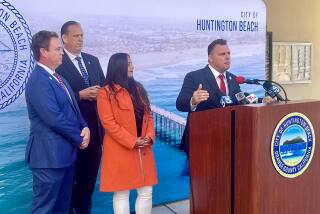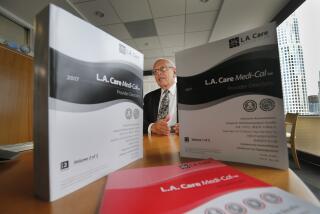City, EPA Reach Accord on Sewage-Dumping Suit
The Environmental Protection Agency and Los Angeles have reached a tentative agreement in a decade-old lawsuit over the dumping of sewage into Santa Monica Bay that would commit the city to spend $2.3 billion on sewer improvements, The Times has learned.
City officials, who have missed repeated deadlines to comply with federal clean-water rules, would receive an extension until 1998 to fully treat the massive quantities of partially treated waste water now pumped into the sea, according to sources familiar with the agreement.
But the settlement, if approved by a federal district judge, would require the city to stop dumping concentrated sewage, known as sludge, into the ocean off Playa del Rey by the end of 1987, sources said. The city had missed a 1980 deadline, and another deadline last February, for halting of the sludge dumping.
A “monetary commitment” of about $600,000--in essence, a fine for the city’s repeated failure to comply with the law, according to one City Hall source--is reportedly included in the agreement.
Higher sewer fees would help pay for the construction work. City officials have prepared a plan to gradually double the current monthly fee of $5.20 for an average residence to $11.63 in 1993. Higher business fees, sharply higher industrial charges and the sale of bonds are also anticipated.
EPA officials in San Francisco and a spokesman for City Atty. James K. Hahn confirmed that a settlement “in principle” has been agreed upon. But they declined to release details until each party gives its final approval and the agreement is filed in federal District Court as a proposed consent decree, perhaps as early as next week.
The Los Angeles City Council initialed the draft settlement in a closed session Wednesday, City Hall sources said.
The EPA, the U.S. Department of Justice and the state Regional Water Quality Control Board still must give their approval, and the plan must be submitted to U.S. Circuit Judge Harry Pregerson, who has jurisdiction over the civil suit filed in 1977 by the EPA.
Disposal of the city’s sewage at sea has been called by marine experts one of the largest sources of ocean pollution on the West Coast.
Toxic Chemicals
In recent years, studies have discovered elevated levels of DDT and PCBs--two highly toxic chemicals--in people who regularly eat fish taken from Santa Monica Bay. Sea life is no longer found on the ocean bottom where the sewage flows from huge pipes except for large colonies of worms that feed on the sewage.
If the deadlines remain as proposed in the draft agreement, it would mean a substantial victory for the city, which has faced the threat of fines for being in violation.
While most other urban areas upgraded their sewer systems, Los Angeles officials spent the 1970s angling for waivers from the Clean Water Act rules that called for an end to dumping of sludge and required full secondary treatment of waste water.
Sanitation officials argued that the ocean off Los Angeles was much hardier than that offshore of urban areas such as New York City, and one expert retained by the city even concluded that sewage was “good for fish.”
Delaying Tactics
While they sought the waivers, Mayor Tom Bradley approved a strategy of delaying improvements to the sewer system in the hope that massive federal financing would be obtained.
After the EPA filed suit, the city in 1980 agreed to stop dumping sludge by last year. But a new, innovative plant to dispose of the sludge by burning it to make electric power has not yet been completed.
The city still held out hope for a permanent waiver from the requirement for secondary treatment of waste water until last year. But the erupting controversy over Santa Monica Bay pollution led the state to reject Los Angeles’ request for a waiver, and the EPA also denied the waiver.
Gamble Backfires
And, as it turned out, the gamble on federal aid backfired when the Reagan Administration reduced financing for local sewer problems and the city now faces a large bill that it must finance locally.
The City Council gave preliminary approval for the massive construction program in June, but the draft agreement is expected to lock the city into completing the work. About $1.3 billion is for extensive work on the sewers themselves and the main Hyperion treatment plant near Los Angeles International Airport. About $1 billion is for added operating costs until the end of the century.
More to Read
Sign up for Essential California
The most important California stories and recommendations in your inbox every morning.
You may occasionally receive promotional content from the Los Angeles Times.










